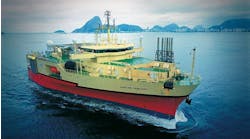Eliminating scope creep
Tim Crumrine
Roy Nelson
Carlos Cordeiro
Mike Loudermilk
Christophe A. Malbrel
Baker Oil Tools
Poor interface management can lead to time overruns and negatively impact the relationship between time, cost, scope, quality, and resources. The trend of streamlined organizations with reduced staffing often requires companies to rely on multiple parties to complete a project. Even with the trend of streamlining, deepwater operators are challenging themselves to drill more complex wellbore architectures, and subsea sand control completions are becoming increasingly intricate. The development of such wells poses particular risks due to the completion complexity and requires a high degree of interface management to ensure operational success.
Strategic issue
In the oil and gas industry, integrated service providers are increasingly used by operators as key project management platforms to design and execute complex field developments. This growing trend is the result of an industry-wide strategy of outsourcing resources and relying on a very lean staff to complete evermore complex projects. Fast-track deepwater, HPHT or brown field re-developments are examples of such projects where technology innovation, flexibility and reactivity are considered critical by operators in their vendor selection process. When large, complex projects such as the ones described here are outsourced, another key factor to consider by the operator is the assurance that service providers have adequate project management resources. This helps ensure the capability to handle changes effectively and reliably in order to deliver a project on time and within budget.
Interface management
As the industry increases design complexity in field development, it becomes apparent that interface management (IM) has become a strategic issue within the industry because it often conditions success and always impacts the economics of a project.
In our industry, poor interface management often leads to time overruns, and negative impacts on the relationships between time, cost, scope, quality, and resources can be represented graphically as the Project Management Triangle.
IM failures have occurred for years, but came to a harsh light with the Three Mile Island nuclear incident in 1979 when it was found that people in key positions made assumptions without checking with one another, which ultimately led to the disaster. Investigations into other disasters have highlighted interface management failure as the root cause in the Piper Alpha, Exxon Valdez, and Phillips’ Pasadena accidents. In our industry, poor interface management often leads to time overruns and negative impacts on the relationships between time, cost, scope, quality, and resources.
So, exactly what is interface management and how can it affect scope creep in subsea sand control completions? Interface management as described by the Project Management Institute is the management of communication, coordination, and responsibility across a common boundary between two organizations, phases, or physical entities which are interdependent. In essence, interface management is the “glue” that holds a project together.
In a risk-averse environment such as the oil and gas industry, IM’s impact on scope creep usually translates as time overruns. Poor IM can cause project milestones to be missed, ultimately creating a domino effect leading to costly project delays.
Scope creep
The problems stated above lead to scope creep in which the balance between project scope, time, cost, quality, and resources is upset. Scope creep is the continual addition of unplanned work to the project, due to changing project requirements driven by a perceived shifting focus. Lack of IM may cause a shift in project focus due to lack of coordination and this can cause the entire project to suffer. For example, if the project scope changes and time and cost remain constant, then quality or resources suffer. Resources may be overworked, and quality can be compromised.
There have been attempts in the past to address IM by controlling the project via computer programs. Microsoft Project, Schlumberger’s Well Learning System and OGCI’s Drilling Management System3 are all examples of these. The problem with these programs was and continues to be the actual computer and person interface. They are limited by the availability of training and computer access for the project participants.
The system interfaces describe the actual way two or more subsystems such as bottom-hole assemblies, upper completions, intelligent well systems, and topsides will work together.
A roadmap can be developed to deal with IM issues early on in the project life cycle for subsea sand control completions, so that potential problems can be mitigated and scope creep can be eliminated.
Interface categories
The social interface relates to the significance of human involvement in complex projects. It is important that interactions between people be managed and carefully coordinated to avoid incidents resulting from misunderstanding or lack of cooperation. At the heart of the social interface is a “social contract” that defines how project teams and their contractors will work together. At the top of the social interface pyramid is the project owner. This may be the person who owns the asset, funds the project, or sanctions the project on behalf of a third party. It is the responsibility of the project manager to act as the liaison between the project team and the project owner, and to represent the interests of both parties. It is important that the project manager aligns the project team’s charter with the goals and objectives of the project owner.
The project team-to-phase workflow interfaces are part of the project management plan. They define the relationship between the different parties during the various project phases required to complete the scope of services as defined in the project work breakdown schedule. This interface is broken down into the planning phase and execution phase.
The system interfaces describe the actual way two or more subsystems such asbottom-hole assemblies, upper completions, intelligent well systems, and topsides will work together. It is vital to document during the planning phase how subsystems will work together to avoid installation conflicts, fishing difficulties, and potential workovers. System interfaces are categorized as: (1) The technological interfaces which describe the performance interfaces between the subsystems of the final well completion and the configuration and functional interfaces and (2) The technological interfacesdescribing the performance interfaces between the subsystems of the final well completion.
Problemsand solutions
Interface management deficiencies are most often illuminated when conflicts arise. Planning of interface management conflict resolutions should be included in the project charter and the work breakdown schedule (WBS). The project manager must provide the project team and contractors with interface management values and beliefs at project commencement. The root causes of many interface management failures can be broken down into poor definition of project interfaces, mismanagement of responsibilities, and poor social interface management. The poor definition of project interfaces often becomes apparent when scope creep is associated with project tie-in points during installation, or when processes affect multiple sub-systems. Mismanagement of responsibilities is a common problem revolving around shifting responsibility between the project management team and those contracted for the project. Poor social interface management evolves many times after negotiating a contract, with the involved parties having different expectations from the contract.
To mitigate poor social IM it is necessary to merge both the economic and social contracts so that they mutually reinforce one another. It is up to the project manager to forge a contract that is not just a list of mutual obligations. Differing views must be aligned at the project onset with key people working under the contract involved in the discussion. A mutually beneficial “social contract” can both aid in the further development of information sharing and reduce costs related to conflict resolution.
IM cases
In one of the first TAML level 5 multilaterals completed in Brazil, proper IM led to a successful project by allowing a service company and operator to overcome a significant problem. One of the operational goals of the project team was to smooth out a window cut in the 9 5⁄8-in. 47 ppf mainbore. The top few joints of the mainbore were 9 5⁄8-in. 53.5 ppf, and consequently the casing hanger was also set up for the heavier weight casing. The watermelon mill that was to be used to smooth out the casing exit was designed for 47 ppf casing and would not drift through the casing hanger. Therefore another assembly was needed to swage the casing hanger and top joints, resulting in time delays and additional cost to the project. This problem could have been avoided early on through the employment of IM. At the end of the day, the project owner and the project team worked together by renegotiating the terms of the contract. This was made possible by the strong “social” contract generated at project commencement.
A roadmap can be developed to deal with IM issues early on in the project life cycle for subsea sand control completions, so that potential problems can be mitigated and scope creep can be eliminated.
In the second case a subsea sand control completion in the Rio Muni basin of West Africa was involved. The wells are routinely completed with frac packs completions utilizing one trip perf and pack systems. Because of the high cost of working in remote locations, these types of systems work well to reduce rig time. To further minimize rig time, one project team used multi-cycle flapper valves and hydrostatically set production packers in the uphole completion assembly. Once the uphole completion was landed in the subsea hanger, the hydrostatically set production packers were set without intervention by pressuring up against the multi-cycle flapper valve. This simplified landing the completion in subsea and reduced rig time by eliminating the need for wireline and provided a method to prevent excessive fluid loss while tripping the uphole completion. This is an example of using proper IM to not only manage many interfaces, but to eliminate unnecessary interfaces.
IM roadmap
It is important to realize that interface management has many pieces, all of which must work in conjunction with one another. IM is an ongoing process and should be considered dynamic throughout the life of the project, with the goal being to maintain the balance between scope, time, cost, quality, and resources. A successful project ends with a “fit for purpose” and high quality completion system that closed on time and within budget. Interface management is the key to keeping all components in balance.
Unless project managers understand the importance of interface management, they run the risk of experiencing cost and time overruns, and exposing the project to increased risks associated with design changes and scope creep. Proper interface management is essential to creating a completion system that is fit for purpose, high quality, within budget and on time.•
Acknowledgements
The authors of this paper would like to thank all inside and outside Baker Hughes who promote project management as a discipline, and understand the intricacies of interface management. Our deepest appreciation also goes to those who have supported this effort both at home and in the office.
Editors Note:This paper was prepared for presentation at the 2005 SPE Latin American and Caribbean Petroleum Engineering Conference held in Rio de Janeiro, Brazil, 20-23 June 2005.






